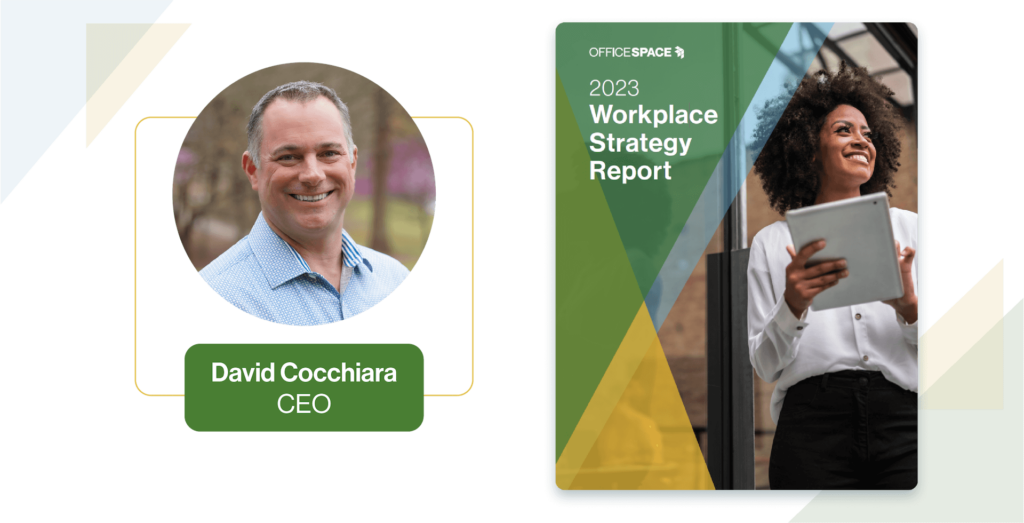Everyone understands the importance of fostering the right culture in the workplace. But this is an increasingly complex task, as more and more companies commit to hybrid and remote environments. Even the best companies may be unsure how best to support employees and maintain a shared set of values in this future of work.
OfficeSpace’s 2023 Workplace Strategy Report is designed to help leaders gain a better understanding of where the workplace is going. This is along with how their own workplace is keeping pace. The report clearly finds that leaders are trying to support their employees in this ‘new normal’. But they’re unsure what that support should exactly look like.
We sat down with OfficeSpace CEO David Cocchiara to gain insight into how companies can answer these questions, using the spaces and software available to them to enhance employee performance and engagement. A hybrid leader himself, Cocchiara discusses how hybrid work impacts culture in the workplace. We also explore how hybrid leadership can create a more positive work environment. One that supports their people and their core values.
Read part one of our interview with David Cocchiara: Workplace metrics: David Cocchiara talks data and hybrid

What impact does the physical office itself have on company culture in the workplace?
In the right circumstances, the office can be 100% supportive of a company’s culture. When set up properly, I think the right type of work environment can have a really positive impact. Both on teamwork and culture. If the office itself helps people feel like they’re engaging and collaborating, a strong culture will follow.
But the inverse is also true. If you’ve got an office setup like you sometimes see in the movies and on tv, where it’s gray and dull and all the cubes look the same and everyone’s bored at their desks… That’s not an environment that’s very engaging.
So the physical office can have a negative impact on your workplace culture if people aren’t engaging when they’re there. It’s hard to build a positive work culture when people spend day in and day out in a workspace that’s just not engaging them as a human being or as a worker.
On the flip side, if companies make sure employees are coming in for the right reasons, if employees are engaged in the right ways, if you regularly ask employees what’s working and not working in the physical office—that will have a big impact on culture and workplace well-being.
Why are companies still struggling to come up with a hybrid work policy that matches their culture?
Because people are weird! But seriously, it’s a big challenge to come up with the right work environment for your people. And getting hybrid work right is a journey for everyone.
Plus, one size does not fit all, so everyone needs to figure out what’s right for them.
Every company is going to be different. This includes their organizational culture, their work requirements, and the types of teams or number of people in a space.
Prior to COVID, we were starting to see an increase in remote work, but it was happening really slowly. There were certain companies that were remote-first, but they were really the exception. But plenty of businesses just liked to be able to look across their floors and see heads in seats. Then, they could assume that that meant work must be getting done.
Then, of course, we were forcefully transitioned into fully remote work for a while. That was stressful, but people didn’t really have a choice. When we talked to workplace leaders at the time, their biggest concerns were around how to make their return to the office safe for everyone. Creating an optimized hybrid schedule that balanced business goals and company values wasn’t necessarily top of mind. Now that we actually have that choice, things are a lot more complicated.
And then some of the struggle around creating the right hybrid policy for business success tends to be generational. There can be big differences in what motivates different generations in the workplace. I always used to wear a suit early in my career. And I went to the office every day without thinking about it—that was just what you did. And so it’s hard for me and many of my cohorts in leadership teams to imagine how we could have personally advanced the way we have, without those relationships that we built in-person.
But of course, in younger generations, relationships are built virtually all the time. I look at my kids who aren’t getting on the phone. They aren’t talking to people in person; they’re building and strengthening relationships just as much as we did. They’re still engaging and communicating, but it’s just in an entirely different way. Some leaders don’t fully understand this yet.
And then you have to add the employment dynamics, where we’ve had a pretty competitive job market for top talent.
Companies have to focus more on fostering a good work-life balance and positive workplace culture than ever before. And that’s a good thing.
So you have a generational divide, along with macroeconomic factors and lots of competition for new employees. All of this has created this challenging dynamic, where people know we’re in a big, transformative moment. The way we view the office is changing. And we have an incredible opportunity to reshape how we work for the better. But we don’t really know the right way to approach it yet.
That was actually a big impetus for writing our Workplace Strategy Report. We knew from the many conversations we have with clients that across the board… People are still trying to figure things out. We wanted to show workplace leaders that they’re not alone if they’ve still got some uncertainty. We’re in a unique, once-in-a-life transition, and there’s just a lot of uncertainty around the workplace right now.

How can leadership help create a more positive culture and work environment?
Transparency is huge. Talking with employees and including them as you make decisions for the workplace instead of just telling them what to do. That improves connection, and it really has a positive impact on culture.
And you can’t overstate the importance of communication. Leaders also need to remember that communication is bidirectional. You need to listen to your employees and work together to find the right solution for your new hybrid office.
If you then tie that transparency and communication into a commitment to engaging with employees in the right way and trying to make the types of workspaces that improve employee experience along with the company’s performance. I don’t know how doing that could have a negative impact on culture.
Getting down to some specific tactical initiatives that can help with the engagement piece. You can look at reshaping the office so that there’s more of this or less of that. Maybe you add more shared seating. Or maybe you make better collaborative workspaces, or perhaps you improve some of your hybrid workplace technology.
But really it’s that transparency and bidirectional, open communication that is going to produce the best work and the best culture in the long term.
What can companies do to create hybrid policies that support both business goals and their culture in the workplace?
It’s going to take a little bit of time for people to settle into a hybrid strategy. One that suits their people, their corporate real estate, and their corporate culture. I don’t think we’ve had enough time post-pandemic for employees to really figure out how much time they want to spend in the office. Or for companies to know exactly how they want to reshape the workplace.
We’re still in a place of trying to figure things out, and that’s ok. But one thing that is consistent across all the conversations I’ve had with other workplace leaders. They all recognize the need to be able to measure what’s working and what’s not. That’s where software can step in as a valuable tool. It can provide real-time metrics around how people are using space and why. And whether it’s engaging and creating the inclusive company culture we’re all shooting for.
So as all businesses are going through these twists and turns, they all recognize the need to be able to test and measure to figure out a new hybrid environment that works for them.

We know from the Workplace Strategy Report that companies are evenly split on whether they should mandate office attendance. How should leadership approach office attendance policies?
Of course all leaders are different. But overall we all really need to listen to our employees. You need to understand what’s driving the best experience for them day-to-day. That way, they can be the most engaged and productive for your business.
That doesn’t mean that you have to do every single thing they ask for. But all sides of the workplace—employers and employees—are grappling with what they want the future of the workplace to be. How can we make hybrid work work? We need to approach that question together.
We know why leaders want their people to come to the office more. According to the Workplace Strategy Report, 65% of leaders want people in the office more primarily to improve collaboration. And 59% want them in-office to improve culture. Both of which have implications on things like employee retention and attraction, and ultimately your organization’s success.
But you also need to listen to what your team members see as the benefits of using the physical office. What do they enjoy about the office? Is it a free lunch, a good conversation, face-to-face time with an executive, or some other perk? And where do they see the opportunities for making your space more efficient and engaging?
Then this all ties back to your ability to test new things and stay agile. As you start to make changes or implement new policies, you can track the results to see what’s working. If you’re going for employee engagement, you’ll use engagement surveys. If it’s retention, you look at retention rates. And hopefully you’re also seeing that highly engaged employees are also high-performing employees who then bring other benefits to the company.
So I think the best approach is listening to your employees, collecting the right data, and then figuring out how to tie that together with your company’s mission and business needs. I think if you do that right, then the mandating part doesn’t feel as mandated. It doesn’t feel like the boss is just arbitrarily telling you to come in on a set schedule all of a sudden.
And of course, that assumes that both sides have really spent time listening to each other and what they’re trying to accomplish, and the value that they see when they get together to engage in the office. That’s what helps support your healthy culture
Do you think leadership is getting the message across to employees about why they want people to come in? If not, what can they do to help employees understand the benefits of the office?
It’s hit or miss right now on whether that message is getting across. I think anyone who wants to do a better job here should be highlighting any wins.
So maybe you see that after a quarter of Team A coming into the office on Tuesdays and Thursdays, using those days for small group work, their engagement score shoots up. Then you should share that result with your whole organization! Maybe Team B is struggling a bit and could benefit from the example.
And then the more you’re able to test, measure, and iterate different approaches and policies, then the more your successes can start to snowball.
We just talked about the importance of really listening to your people, but transparency is important too. Employees need to know why you’re doing certain things, and what you’re seeing and hearing in the results.
Beyond that, I think it’s just going to take a little bit more time and a little bit more testing and being willing to try new things and share the results. Workplace transformation doesn’t happen overnight.
This is also where workplace experience software can really step in as a valuable tool. That’s because there’s no other way to really measure how much space is being used, how people are using it, why they’re using it, and how engaged they are.

What are some examples you’re seeing of companies that are getting their hybrid culture and approach right?
LIke you might expect, it’s our clients that had a positive remote environment prior to the pandemic that have better figured out how to do hybrid now.
Of course, these groups were absolutely in the minority pre-pandemic. They already had the concept of flexible working down, and they were already bringing people together for the right activities. They’d often be startups, those in technology, and those in areas like manufacturing, financial services, and consulting. They already had a more flexible work culture than more traditional 9-to-5 in-office workplaces, so they’ve been able to adapt more quickly.
Meanwhile, very traditional companies with very programmatic career paths have struggled a bit more to figure out that balance of the right growth paths for their employees and mandating time in the office. It can be done, but it will take more time and effort.
Ultimately, it’s just a really interesting time to be in this space, trying to create a hybrid workplace experience that balances an organization’s values with what keeps employees happy, healthy, and engaged. If you think back to even just five or ten years ago, the office itself was just a place where people went to do work. Most of us didn’t think much about how the physical office space was being used, or how it was benefiting people. It was just something that had always existed.
And now we’re at a point where I don’t think we’ll ever go back to that static view of the office or be in a place where the majority of companies are working in the office five days a week. It’s been a complete cultural shift.
So, yes, we’re in a weird place now, but we also have an opportunity to reshape the way people work, and to reshape the way we think about the way people work.
The office is becoming a place that should encourage collaboration and foster culture in the workplace, and help people grow and be productive.
That’s why it’s really been exciting to see how we at OfficeSpace can have a big impact as people are navigating these uncharted waters. More and more people are beginning to see the profound impact that space management software and office workplace technology can have in terms of helping to transform the office and the way we work for the better.
It’s not very often that you can be in a space that is so impactful to both employees and for the people running their companies. So it’s a challenging time for companies and for culture, but also a really exciting one.
OfficeSpace offers easy-to-use software that can help companies develop the right strategy to support culture in the workplace. Reach out for a free demo.
Photos: YurolaitsAlbert, VioletaStoimenova, PeopleImages, skynesher




